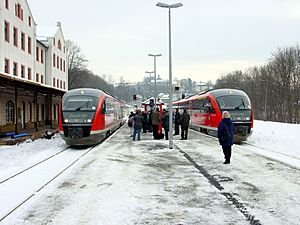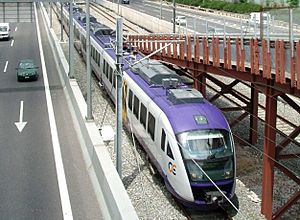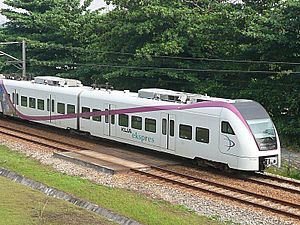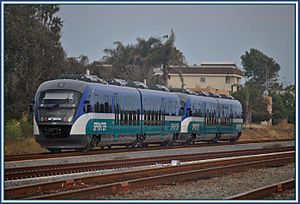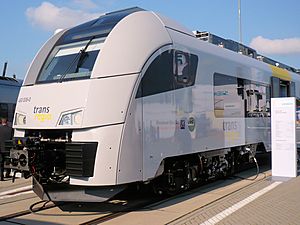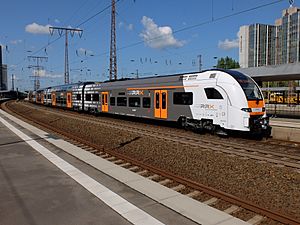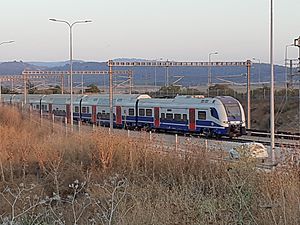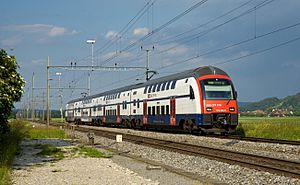Siemens Desiro facts for kids
Quick facts for kids Siemens Desiro |
|
|---|---|

Desiro train in Graz, Austria
|
|
| Manufacturer | Siemens Mobility, Ural Locomotives |
| Family name | Desiro |
| Specifications | |
| Maximum speed | 140 km/h (87 mph) in some Desiro RUS 160 km/h (99 mph) 180 km/h (110 mph) in Desiro UK |
| Track gauge | 1,435 mm (4 ft 8 1⁄2 in) standard gauge |
The Siemens Desiro is a group of passenger trains. They can be powered by either diesel or electricity. These trains were created by Siemens Mobility. This company is part of the big German company Siemens AG.
Desiro trains are often used for short trips between towns. They are also used for longer regional journeys. They can speed up very quickly. This makes them great for routes with many stops. The Desiro design is very flexible. You can find these trains in many countries across Europe.
There are several main types of Desiro trains. These include the Desiro Classic, Desiro ML, Desiro UK, Desiro City, Desiro HC, and Desiro RUS.
Contents
Desiro Classic
The Desiro Classic is one of the first types of Desiro trains. Many countries use them for local travel.
Austria
The Austrian Federal Railways (ÖBB) uses 60 diesel Desiro trains. They are called ÖBB 5022. These trains are similar to the Class 642 trains in Germany.
Bulgaria
In 2005 and 2006, Bulgarian State Railways started using Desiro trains. They bought 25 diesel trains from Siemens. By March 2006, 16 trains were delivered. Many of them ran on the Sofia-Kyustendil-Sofia line.
Bulgaria also ordered 25 electric Desiro trains. These electric trains were prepared in Varna. They are called classes 30 and 31. They serve areas around Sofia and Plovdiv.
Czech Republic
A private railway company called Arriva vlaky uses two Desiro trains. They borrowed these trains from Deutsche Bahn in Germany.
Denmark
In Denmark, DSB has rented 12 Desiro trains since 2002. They first used them between Odense and Svendborg. They also ran between Odense and Fredericia. Later, they moved to the Lille Syd line.
In 2009, DSB ordered eight more Desiro trains from Siemens. These trains started service in December 2010. They also served the Odderbanen line from 2012. These lines closed in 2016 to become a light rail network. The trains then moved to the Svendborgbanen line.
Nordjyske Jernbaner has used Desiro trains since 2004. This company now owns eight Desiro trains.
Germany
Germany's Deutsche Bahn started using two-car Desiro trains in 2000. These trains are called Class 642 units. They can go up to 120 km/h (75 mph). They are mainly used on smaller lines and regional routes. Deutsche Bahn bought 234 of these trains by 2007. Other private German rail companies also use Desiro trains.
The Class 642 has two diesel engines. Each engine can produce 275 or 315 kW (369 or 422 hp) of power. They usually have 100 seats. Up to three train sets can be joined together. Passengers generally like Desiro trains because they speed up quickly. They have helped make journeys faster.
Greece
In Greece, eight diesel Desiro trains were used temporarily. This was between 2004 and 2006, and again in 2007. They ran on the Athens–Chalkida line. They also served the Athens suburban railway lines.
Greece also has twenty electric Desiro trains. These are called OSE class 460. They use a special overhead power system. They run on suburban lines around Athens. They also run between Thessaloniki and Larissa.
Hungary
Currently, 31 diesel Desiro trains are used by MÁV in Hungary. This includes the eight trains from Greece. They are mainly used for suburban travel. For example, they run between Debrecen and Nagykereki. They also serve as express trains between Budapest and Baja.
Malaysia
The KLIA Ekspres is a train service to Kuala Lumpur International Airport. It uses Desiro ET 425 M electric trains. These trains have four cars. Twelve train sets are in use. Eight trains run non-stop to the airport. Four trains stop at three stations, including Putrajaya. These trains can reach 160 km/h (99 mph). This makes them the fastest trains in Malaysia.
Romania
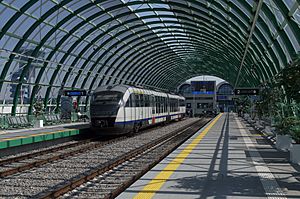
Căile Ferate Române (CFR) is Romania's national railway company. It is one of the biggest users of Siemens Desiro trains. CFR has 120 diesel Desiro trains. They use them for both "Inter Regio" and "Regio" services. The trains are called CFR Class 96. Their nickname is "Săgeata Albastră", which means 'The Blue Arrow'.
At first, some people thought Desiros were not comfortable for long trips. CFR has updated them. Now, they mostly use Desiros for medium and short-distance routes. They plan to use them for a new commuter link in Bucharest.
Slovenia
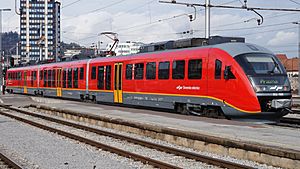
Slovenian Railways uses 30 electric Desiro trains. They are called Desiro EMG 312 SR 31E. These trains are used for local trips on electric lines. For example, they run from Ljubljana to Koper.
United States
The Sprinter light rail system uses VT642 Desiro diesel trains. It serves Northern San Diego County, California. The line is 35 km (22 mi) long. Twelve train pairs were delivered in 2006. Service started on March 9, 2008. It serves fifteen stations.
Desiro Mainline
The Desiro Mainline (ML) is a newer version of the Desiro train.
Austria
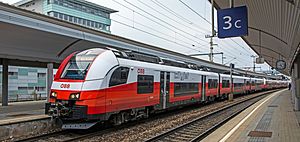
In 2010, ÖBB in Austria agreed to buy up to 200 Desiro ML trains. The first trains started running on the Vienna S-Bahn in 2015. They are called class 4744/4746 cityjet. By the end of 2021, ÖBB received all 200 trains.
In 2021, ÖBB ordered 21 more four-car cityjet Desiro ML trains. These new trains will have more than 290 seats.
Belgium
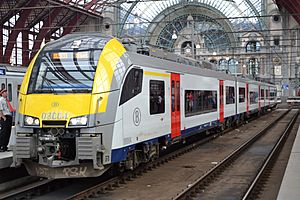
In 2008, NMBS/SNCB in Belgium ordered 305 Desiro ML trains. In 2013, the order for the last 250 trains was paused. This was because of technical problems with the trains already running. The company asked Siemens for money because of these problems. Siemens had already been fined for delivering the first trains late. The full order was confirmed in 2013. The last two trains arrived in March 2015.
In 2014, the head of NMBS/SNCB said that Desiro trains needed repairs too often. They needed fixing about every 8000 kilometers. These trains are used a lot on the Brussels Regional Express Network. They also run on InterCity lines.
Germany
The Desiro ML Mittelrheinbahn is used by a private company called trans regio. They use them for regional services between Cologne and Mainz. These electric trains can go up to 160 km/h (99 mph). However, they are limited to 150 km/h (93 mph) due to their braking power. More middle carriages can be added to these trains later.
Desiro RUS
Russia
The Desiro RUS trains are called ES1. They are electric trains made for Russian Railways. Russian Railways calls them Lastochka (which means "Swallow" in English). These trains are designed for Russia's wider railway tracks.
In January 2013, Russian Railways started using the first 18 trains. In mid-2013, Siemens and Ural Locomotives began building more trains. They built them at a factory in Ekaterinburg. The first train from this factory was made in June 2014. Most of its parts were made in Russia. The factory plans to make 240 trains by 2021.
In 2011, Russian Railways ordered 1,200 train cars. Siemens also has a contract to maintain these trains for 40 years. This contract is worth about 2.5 billion euros.
Desiro RUS trains come in six types. A new version called Vostok (East) will be able to have 3 to 12 cars. It will start being made in 2023-2024.
Desiro UK
Siemens calls its trains for the United Kingdom and Thailand Desiro UK. These trains look different from the Desiro Classic. They have modern features. These include special tanks for toilet waste. They also have comfy seats and automatic announcements.
Thailand
Nine Desiro UK electric trains are used in Bangkok, Thailand. They are based on the British Rail Class 360 trains. They run on the Suvarnabhumi Airport Link. This line connects Phaya Thai Station to Suvarnabhumi Airport. The trains have a larger air conditioning unit on the roof. This helps them cope with Thailand's hot weather. The trains were built in Krefeld, Germany. They were delivered starting in 2007. The train line opened in 2010.
| Class | Image | Operator | Introduced | Number | Power | Carriages | Door configuration | Car length | End Gangway |
|---|---|---|---|---|---|---|---|---|---|
| Class 360/2 |  |
Asia Era One Company Limited | 2010 | 9 | AC electric | 3-4 | High-volume | 20 m (65 ft 7 in) | No |
United Kingdom
EMUs
The first Desiro UK trains were ordered by South West Trains in 2001. They were for short and long-distance services from London Waterloo. These new trains replaced older ones that were over 40 years old.
The new Desiro UK trains became two different classes. Both use a 750 V DC third-rail power supply.
- 110 Class 450 four-car trains started service in 2003. They are for commuter services.
- 45 Class 444 five-car trains started service in 2004. They are for longer inter-city services.
An extra 17 Class 450 trains were ordered. They started service by early 2007.
First Great Eastern bought 21 Class 360/1 four-car trains. These use a 25 kV overhead electrical supply. They run from London Liverpool Street to Clacton-on-Sea and Ipswich. They started service in 2003.
Heathrow Connect ordered five Class 360/2 four-car trains. They were for services between London Paddington and Heathrow Airport. These trains were later made into five-car units. In 2018, these trains moved to TfL Rail. In 2021, Rail Operations Group took over the Class 360s. In 2022, some were scrapped, and others were sold.
For the West Coast Main Line update, 30 Class 350 trains were ordered. They can use two types of power. They are operated by West Midlands Trains. In 2008/09, another 37 Class 350/2 four-car trains started service. Then ten Class 350/3 units followed in 2013. First TransPennine Express received ten Class 350/4 units in 2013.
First ScotRail ordered 22 three-car and 16 four-car Class 380 trains. They started service on December 8, 2010. They replaced older trains on lines like the Inverclyde Line.
| Class | Image | Operator | Introduced | Number | Power | Carriages | Door configuration | Car length | End Gangway |
|---|---|---|---|---|---|---|---|---|---|
| Class 350/1 |  |
West Midlands Trains | 2004 | 30 | AC/DC electric | 4 | High-volume | 20 m (65 ft 7 in) | Yes |
| Class 350/2 | 2008 | 37 | AC electric | 4 | High-volume | 20 m (65 ft 7 in) | Yes | ||
| Class 350/3 | 2014 | 10 | AC electric | 4 | High-volume | 20 m (65 ft 7 in) | Yes | ||
| Class 350/4 | 2013 | 10 | AC electric | 4 | High-volume | 20 m (65 ft 7 in) | Yes | ||
| Class 360/1 | East Midlands Railway | 2003 | 21 | AC electric | 4 | High-volume | 20 m (65 ft 7 in) | No | |
| Class 360/2 |  |
Global Centre of Rail Excellence (GCRE) | 2005 | 3 | AC electric | 5 | High-volume | 20 m (65 ft 7 in) | No |
| Class 380/0 |  |
ScotRail | 2010 | 22 | AC electric | 3 | High-volume | 23 m (75 ft 6 in) | Yes |
 |
|||||||||
| Class 380/1 |  |
2010 | 16 | AC electric | 4 | High-volume | 23 m (75 ft 6 in) | Yes | |
| Class 444 |  |
South Western Railway | 2004 | 45 | DC electric | 5 | Low-volume | 23 m (75 ft 6 in) | Yes |
| Class 450 |  |
2003 | 127 | DC electric | 4 | High-volume | 20 m (65 ft 7 in) | Yes | |
DMUs
In 2003, First TransPennine Express ordered diesel-powered Desiro UK trains. They use them for inter-city services in northern England and southern Scotland. Fifty-one three-car trains, called Class 185 diesel units, started service in 2006.
| Class | Image | Operator | Introduced | Number | Power | Carriages | Door configuration | Car length | End Gangway |
|---|---|---|---|---|---|---|---|---|---|
| Class 185 |  |
TransPennine Express | 2006 | 51 | Diesel-Hydraulic | 3 | High-volume | 23 m (75 ft 6 in) | No |
Desiro City
The Desiro City trains are designed for busy commuter lines in the UK. They can carry many passengers. They are also lighter and use less energy than older models. They have modern "fly-by-wire" controls.
In 2011, an order was placed for 115 Desiro City trains. These trains have eight or twelve cars. They are for the Thameslink rolling stock programme. These trains are called Class 700.
In 2014, South West Trains ordered 30 Class 707 five-car trains. They cost £210 million. In 2017, South Western Railway announced they would replace the Class 707s. In 2020, Southeastern agreed to use the Class 707s for extra capacity.
| Class | Image | Operator | Introduced | Number | Power | Carriages | Door configuration | Car length | End gangways |
|---|---|---|---|---|---|---|---|---|---|
| Class 700/0 |  |
Thameslink | 2016-18 | 60 | AC/DC electric | 8 | High-volume | 20 m (65 ft 7 in) | No |
| Class 700/1 |  |
2016-18 | 55 | AC/DC electric | 12 | High-volume | 20 m (65 ft 7 in) | No | |
| Class 707 |  |
South Western Railway | 2017-2018 | 30 | DC electric | 5 | High-volume | 20 m (65 ft 7 in) | No |
| Class 717 | Great Northern | 2019 | 25 | AC/DC electric | 6 | High-volume | 20 m (65 ft 7 in) | Emergency only | |
Desiro HC
At a big train show in 2014, Siemens showed its Desiro High Capacity (Desiro HC) train. This train has single-deck motor cars. It can also have up to four double-deck coaches in the middle. This design combines easy access with lots of space for passengers.
Egypt
In May 2022, Egypt ordered 94 Desiro four-car trains. This was part of a large railway project.
Germany
In April 2015, Siemens announced it would build 82 Desiro HC trains. These trains are for the Rhine-Ruhr Express (RRX) project in Germany.
Israel
In September 2017, Israel Railways chose Siemens to supply 60 electric train sets. This means 330 train carriages in total. They will be delivered starting in 2021. The deal is worth US$910 million. Siemens will also build a maintenance center in Ashkelon. They will maintain the first 24 trains.
Desiro Double Deck
The Desiro Double Deck is a train with two levels. It has a low floor for easy access.
Switzerland
Swiss Federal Railways uses double-decker electric trains. They are called class SBB RABe 514. These trains are used for local trips in Zürich. They are part of the Zürich S-Bahn system. 61 four-car sets have been running since 2006.
See also
 In Spanish: Siemens Desiro para niños
In Spanish: Siemens Desiro para niños
- Alstom Aventra
- CAF Civity
- Stadler FLIRT
- TMH Ivolga



